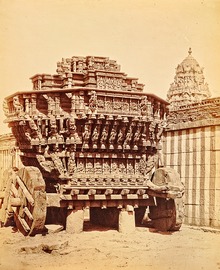Our website is made possible by displaying online advertisements to our visitors.
Please consider supporting us by disabling your ad blocker.
Juggernaut



A juggernaut (/ˈdʒʌɡərnɔːt/ ⓘ),[1] in current English usage, is a literal or metaphorical force regarded as merciless, destructive, and unstoppable.
This English usage originates in the mid-nineteenth century. Juggernaut is the early rendering in English of Jagannath, an important deity in the Hindu traditions of eastern and north-eastern India. The meaning originates from the Hindu temple cars, which are chariots, often huge, used in processions or religious parades for Jagannath and other deities, the largest of which, once set into motion, are difficult to stop, steer or control by humans, on account of their massive weight.
Since the Middle Ages, Europeans had been fascinated by accounts of the Ratha Yatra (lit. 'temple car procession') at Puri, which claimed that pilgrims threw themselves under the temple cars. However, by 1825 it was said: "That excess of fanaticism which formerly prompted the pilgrims to court death by throwing themselves in crowds under the wheels of the car of Jaganath, has happily long ceased".[2] Despite this, a New York Times report from 1864 reported witnessing celebrants deliberately placing themselves under the wheels of the device against the will of the authorities. [3]
- ^ Jones, Daniel (2003) [1917], Peter Roach; James Hartmann; Jane Setter (eds.), English Pronouncing Dictionary, Cambridge: Cambridge University Press, ISBN 3-12-539683-2
- ^ OED, "Juggernaut":1
- ^
"AFFAIRS IN INDIA.; The Great Juggernaut Saturnalia. The Sacrifice of Human Victims". Archived from the original on 2024-12-29. Retrieved 2025-01-04.
The car had been in one place for a whole year, and had made a deep hole for itself by its great weight. Again and again the Brahmins-shouted and gesticulated, laughing among themselves. At last the mob happened to pull together instead of one after the other, and the huge mass moved forward a few yards, groaning as if it had been a living creature. It stopped, and for a few minutes the crowd stood in almost perfect silence. Then the Brahimns again gave the signal, and this time it crushed out a life with every revolution of its hideous wheels, covered as they were with human flesh and gore.
Previous Page Next Page


